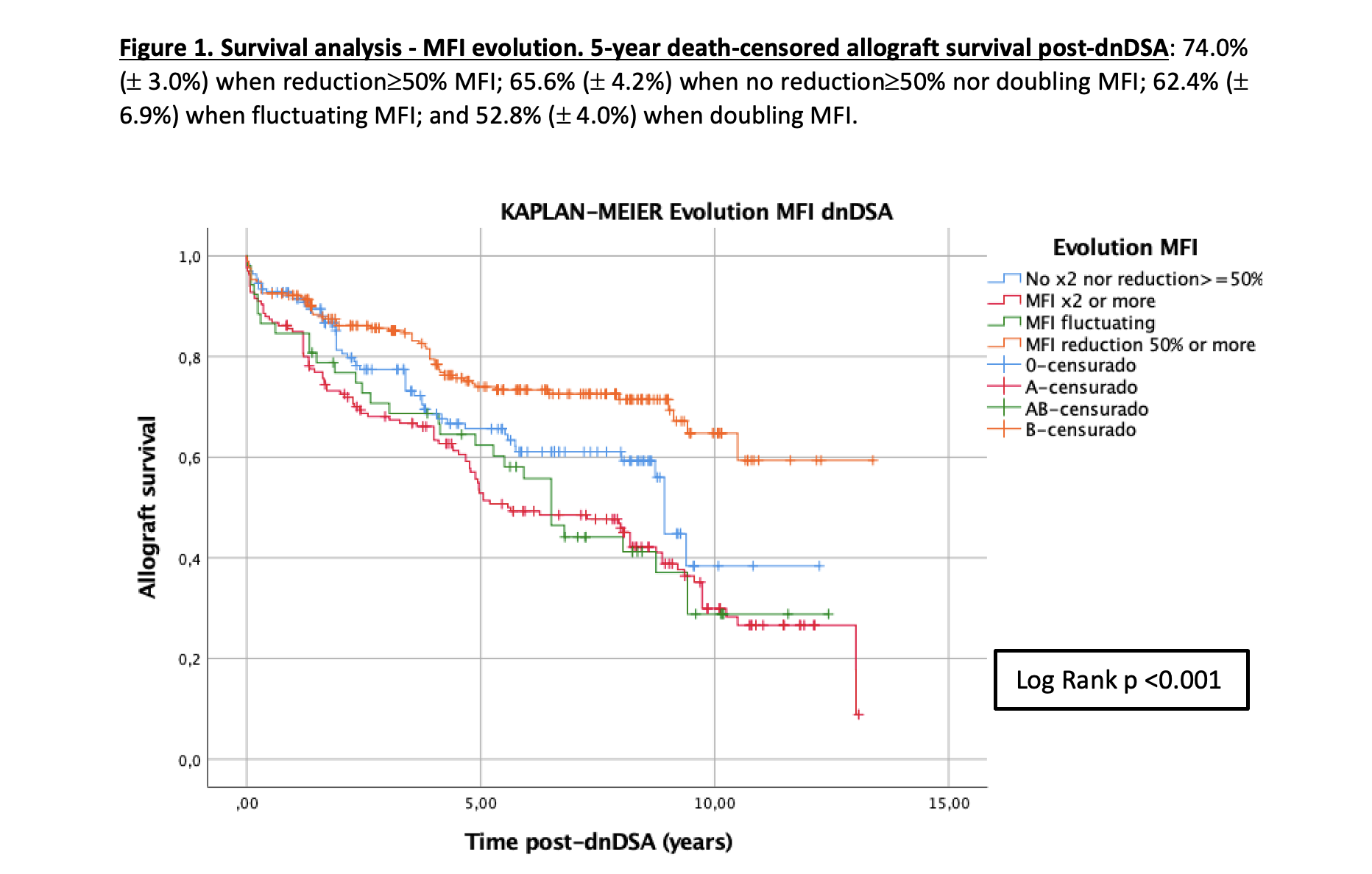The Natural History of De Novo DSA After Kidney Transplantation
1Nephrology department-IDIVAL, Hospital Universitario Marqués de Valdecilla, Santander, Spain, 2Institute for Transfusion Medicine, HLA-Laboratory, Charité - Universitätsmedizin, Berlin, Germany, 3Department of Nephrology and Medical Intensive Care, Charité - Universitätsmedizin, Berlin, Germany
Meeting: 2022 American Transplant Congress
Abstract number: 1408
Keywords: Antibodies, Graft failure, Kidney transplantation, Rejection
Topic: Clinical Science » Kidney » 45 - Kidney Chronic Antibody Mediated Rejection
Session Information
Session Name: Kidney Chronic Antibody Mediated Rejection
Session Type: Poster Abstract
Date: Monday, June 6, 2022
Session Time: 7:00pm-8:00pm
 Presentation Time: 7:00pm-8:00pm
Presentation Time: 7:00pm-8:00pm
Location: Hynes Halls C & D
*Purpose: De novo donor-specific antibodies(dnDSA) are key in the diagnosis of antibody-mediated rejection(ABMR) and are related to graft loss(GL). Luminex® provides semi-quantitative information with the mean fluorescence intensity(MFI). To investigate the impact of MFI evolution on graft survival we performed this study.
*Methods: A retrospective analysis including 400 kidney transplant recipients with dnDSA until 31/05/2021 was performed. Only patients with a functioning kidney and dnDSA against the last graft were included. dnDSA were assessed annually after transplantation and determined by Luminex®(n=691). In general, MFI positivity threshold was 1000, but first occurrence was defined as the date in which dnDSA was first assigned as plausible by an immunologist, regardless of MFI. MFI at first occurrence (MFI<500;500-999;1000-2999;3000-9999;≥10000) and MFI evolution (doubling or more, reduction≥50%, fluctuating or stable MFI) were registered.
*Results: The median time to dnDSA positivity was 11.3 months after transplantation. ABMR was present in 24.8%, and GL occurred in 33.3% over a follow-up period of 9.7 years(IQR 7.2-12.2). Patients with a greater number of dnDSA and those with both class I and II were related to worse graft survival at 5 years post-dnDSA(log rank p=0.008 and <0.001). Analyzing the relationship of MFI with GL, there were no significant differences in MFI at first occurrence, and stable MFI negativity was significantly lower in the graft loss group(p=0.004). There was a greater proportion of MFI≥3000 at first occurrence in class II (p<0.001). MFI reduction≥50% was frequent during evolution(36.9%), and a greater MFI negativity(MFI<500) was observed in class I (p<0.001). MFI evolution predicted allograft survival post-dnDSA (figure 1).
*Conclusions: The presence of both class I and II dnDSA has a negative impact on graft survival, as well as having a greater number of dnDSA. MFI evolution can predict graft failure, being fluctuating and doubling MFI significantly related to worse allograft survival at 5 years post-dnDSA.
To cite this abstract in AMA style:
Moral CLópezdel, Lachmann N, Hergovits S, Stauch D, Akifova A, Naik M, Osmanodja B, Schmidt D, Budde K. The Natural History of De Novo DSA After Kidney Transplantation [abstract]. Am J Transplant. 2022; 22 (suppl 3). https://atcmeetingabstracts.com/abstract/the-natural-history-of-de-novo-dsa-after-kidney-transplantation/. Accessed December 23, 2025.« Back to 2022 American Transplant Congress

